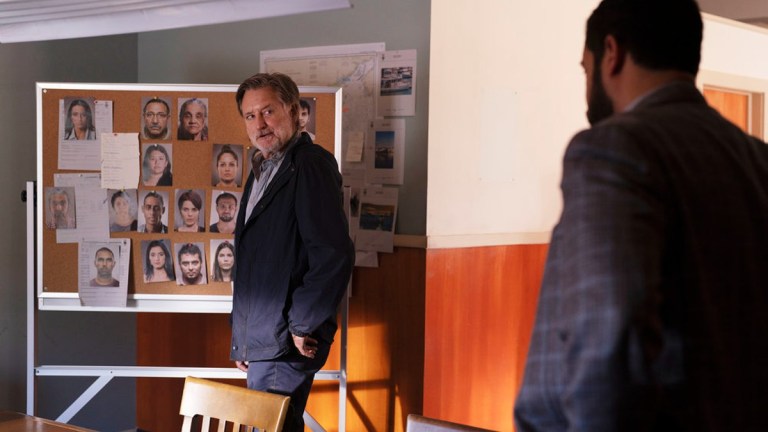The Sinner Season 4 Ending Explained: A Change of Scenery
The Sinner season 4's wide open island setting becomes a prison in its cathartic conclusion.

This article contains spoilers for The Sinner season 4.
Detective Harry Ambrose’s (Bill Pullman) arc drew to an end with the final episode of the fourth season of The Sinner, closing out on a surprisingly cathartic note for a series mired in the very worst things people do to one another. As Ambrose spent much of his run struggling with mankind’s capacity to lie, cheat, steal, and kill, the story allowed him to leave us while gazing into the bright blue sky, finally at peace with what he’d seen and done.
Of a mind with that dreamy final shot, The Sinner has long leaned on a revolving cast and an ever-changing backdrop to grant physical manifestation to Ambrose’s arc. The series pulled this off by shifting from various fictional locations primarily filmed in Upstate New York over the first three seasons and changing to the likewise mythical town of Hanover, Maine, filmed in Nova Scotia, in its fourth.
The traumatic events of last season saw Ambrose finding kinship with a man named Jamie (Matt Bomer), whose nihilistic philosophies mirrored his own, only to discover that he had killed three people either directly or indirectly through his bizarre philosophical experimentations. Ambrose put an end to Jamie’s reign of terror by shooting him, but watching him die, afraid and in pain, derailed Ambrose’s view of the world on a profound level.
Fittingly, then, season four begins with water; our viewpoint plunged into the great, deep, greenish-blue ocean. Ambrose’s lover Sonya (Jessica Hecht) openly states, “we needed a change of scenery,” in the opening sequence as they travel from an idyllic ferry ride to a wholesome lunch meeting with a friend, shot in the postcard-worthy Lunenburg in Nova Scotia. However, as the friend vaguely references the event that led them to desire a change of pace, Ambrose is upset to the point of having to leave the table, showing that there is still much work to be done yet before he’s over the events of the prior season.
A hurting and not yet healing Ambrose runs into Percy Muldoon (Alice Kremelberg), the tragic, tormented figure at the center of this season’s narrative. The two have a pleasant, if cryptic, metaphysical chat, very much in line with the ones he had with Jamie in the prior season. Off of his antidepressants and suffering from guilt-induced insomnia, Ambrose takes to the streets to get some air that evening only to see Percy once again. Concerned, he follows her through the lush green forest at dusk, only to see her, seemingly casually, leap to her death.
In the final moments before Percy goes over the rocky cliff’s edge to the roiling river below, we look out at the open sea surrounding the island with her. For the first time, this image of infinite possibility doubles as a cage that keeps her locked in place, unable to move or even grow beyond it. From this moment on, the dreaminess of the terrain takes on a more ominous undercurrent, showing that things can’t possibly be as tranquil as we once believed.
As Ambrose’s investigation begins, we see how truly small the town is, with repetitive scenes on the docks, at the Muldoon estate, and at the same restaurant and church giving the saga a closed-in feeling despite its scenic location and expansive, apparently limitless horizon. This is not lost on Sonya, who departs about halfway through the story due to a sudden sense of claustrophobia that leaves her nervous and unable to work. Their tidy apartment is ransacked, adding a sense that safety is no longer guaranteed, if it ever truly was. As she leaves, the day is sunny and bright, and the ferry seems clean and untarnished in comparison to the gray, moldering scenery that Ambrose soon finds himself mired in.
There are a number of dialogue cues to indicate that the Muldoons have been a force on the island since the mid-1800s, but that sense of history is very much worked into the fabric of the show. Several filming locations are either protected wildlife areas, like the Ovens Natural Park, or legitimate historical sites, including the Fisheries Museum of the Atlantic, where the show’s Muldoon Fish Company is located. At every turn, we see a world that confirms Percy’s fears of never being able to escape, showing how intricately tied her family is to the region.
In a flashback, grandmother Meg (Frances Fisher) notes that their family first came over in the mid-1800s to escape Ireland’s famous potato famine years, taking nothing and turning it into a family legacy that defined the region, Percy is quick to point out that there were Indigenous people present when they arrived. Attempting to state in no uncertain terms that their presence on the island came at the cost of still-ongoing colonization, Percy is quickly shut down, but the house full of antique photographs all but confirms what she’s said. Though her grandmother sees it as a positive, Percy feels that it’s a trap, but even when she tries to escape, the tides seem only to bring her back to face herself. In her death, her family is forced to do the same.
Meanwhile, the Lams, an Asian-American family who own the local restaurant The Golden Fish, are most often shown in enclosed spaces until the series conclusion. In the beginning, son CJ (David Huynh) is shown to stay indoors as often as possible, while his father Mike (Ronin Wong) sleeps in a side room in the restaurant’s office. As the knowledge of their deceased son Bo is revealed, he is shown to be buried on a small, flat island, where they go to mourn him as a family, the lack of forest and open sea surrounding the land granting a sense of optimism that the family was otherwise denied in the early episodes of the season.
In many ways, the mystery of “Who Killed Percy?” isn’t a mystery at all, and it’s answered in the first episode – Percy did. She set the events leading to her death in motion, and she’s the one who took that fated leap into the void. As the series goes on, the answer is obscured, with complicity stretched out in all directions. Her grandmother may not have explicitly committed a crime, but her guilt shines in her refusal to face the truth of her sons’ and their shady business practices. Yet, in the final moments, even the Muldoons are granted the chance to reconcile, with Meg rolling up her sleeves and the spiritualist that both Percy and Ambrose had individually sought out to allay their feelings of depression and guilt welcoming her home.
The sense of secrecy, foreboding, and cover-up all come to a head in the final episodes, as Ambrose is left again uncertain and questioning. However, as the truth comes out, it opens the door to a more healing path for all. The sun comes out and the skies go from gray to blue once more. The sea no longer seems so foreboding, and the infinite possibility of those first moments return. Ambrose is unsure that he has done the right thing in the end, but takes comfort in the hope that Percy and the others might rest at long last as he finds a bit of peace on the gorgeous beach as the shot fades to black. Ultimately, The Sinner might have asked more questions than it answered, but it gave its characters the tools they needed to find their own serenity.
All eight episodes of USA Network‘s The Sinner are available to stream on Netflix now.
